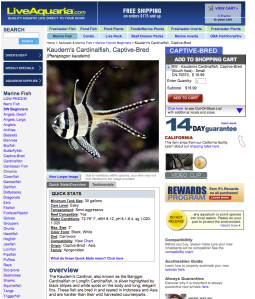
WildEarth Guardians Taylor Jones commends NMFS for listing the Banggai Cardinalfish but says more protections are necessary.
Today WildEarth Guardians, the environmental organization that petitioned National Marine Fisheries Service (NMFS) to list the Banggai Cardinalfish(Pterapogon kauderni) under the Endangered Species Act (ESA), commended the agency on its decision to list the species. “Providing protections for the Banggai cardinalfish is crucial because demand for aquarium fish in the United States is a chief cause of this imperiled species’ decline,” said WildEarth Guardians Endangered Species Advocate Taylor Jones. “These beautiful fish deserve a chance to recover in their wild homes, and should not be relegated to tiny tanks for people’s entertainment.” The Banggai cardinalfish was one of 81 marine species the environmental organization petitioned for listing in July 2013.
Jones says that while she’s pleased NMFS listed the species as “threatened” under the ESA, she believes additional protections are necessary. Species under NMFS jurisdiction that are listed as “threatened” under the ESA do not automatically have Section 9 prohibitions applied to them. As a result, even though the listing will go into effect in 30 days, there will be no change to regulations regarding trade or possession of Banggai cardinalfish unless the agency undertakes additional rulemaking.
“The Service should quickly finalize regulations prohibiting removal of these beautiful fish from the wild,” said Jones. “Endangered Species Act protection will mean much less for these fish if it does not address the main threat: collection from the wild for the aquarium trade.”
NMFS stated in its final rule that they “intend to announce an advance notice of proposed rulemaking to solicit public comment and information on any section 4(d) protective regulation, if proposed, for the Banggai cardinalfish.”
What about Aquacultured Banggai Cardinalfish?

PetCo/LiveAquaria already offer only aquacultured Banggai cardinalfish, advertising them as “hardier than their wild harvested counterparts.”
If NMFS decides to apply Section 9 prohibitions and ban the trade in wild-caught Banggai cardinalfish, what will happen to aquacultured fish? The best available data suggests that in 2013, a single overseas aquaculture facility was providing enough captive-bred Banggai cardinalfish to meet approximately 75% of the average annual US import volume of wild-caught Banggai cardinalfish. NMFS noted this dramatic shift away from a heavy reliance on wild-harvest Banggai cardinalfish for the US aquarium trade in the proposed rule that published in December 2014:
In 2012, a large-scale aquaculture facility based in Thailand began to breed Banggai cardinalfish in captivity for export, which may alleviate some of the pressure to collect fish from wild populations. In 2013, approximately 120,000 Banggai cardinalfish were imported into the United States from the Thailand facility. The volume represents a significant portion of overall United States imports of the cardinalfish and may even exceed the number of wild fish currently imported. Efforts to captive-breed the species in the United States are also ongoing, which may alleviate dependence on wild-caught cardinalfish. In-situ breeding by the fishing communities in the endemic area may also alleviate pressure on the natural population, but the concept requires further research before it can be implemented at a local community level.
In the final rule published in the Federal Register today, NMFS was somewhat less optimistic about the overall effects of both aquaculture and improvements in the management of the fishery. In response to public comment on the proposed rule to list the Banggai cardinalfish as threatened under the ESA, NMFS states that “[c]aptive-bred facilities have recently started in the United States and Thailand and are anticipated to decrease the threat of directed harvest of the wild populations in the future, but the degree to which aquaculture would affect harvest of wild populations is unknown.” In large part, this has to do with new information that suggests less improvement in the fishery than previously thought. This is especially a concern as demand for aquarium fishes increases across Southeast Asia and especially China.
The agency concludes that, despite dramatic increase in aquaculture, “evidence shows that directed harvest for the live marine ornamental reef fish trade and harvest of microhabitat remain concerns.” Additionally, NMFS acknowledges identifying an aquacultured Banggai cardinalfish from a wild banggai cardinalfish “would be difficult” and allowing trade in aquacultured fish, while banning wild ones, potentially opens the door to fraud and illegal activity. Nonetheless, the agency states:
We have not decided which, if any, of the section 9 prohibitions to apply to the Banggai cardinalfish. We intend to announce an advance notice of proposed rulemaking to solicit public comment and information on any section 4(d) protective regulation, if proposed, for the Banggai cardinalfish.
For its part, WildEarth Guardians says it worries about NMFS allowing trade in aquacultured fish. “We’re concerned that allowing trade in aquacultured fish would provide ‘cover’ for illegal trade in wild-caught fish,” said Jones. “However, we also would not want a ban on aquacultured fish to create a higher demand for wild-caught fish, either inside or outside of the US. This is a unique situation in that it is the first aquarium fish listed; in addition, the aquaculture industry has changed rapidly since the petition was submitted. We want NMFS to do what is best for the species, taking all those factors into account.”
